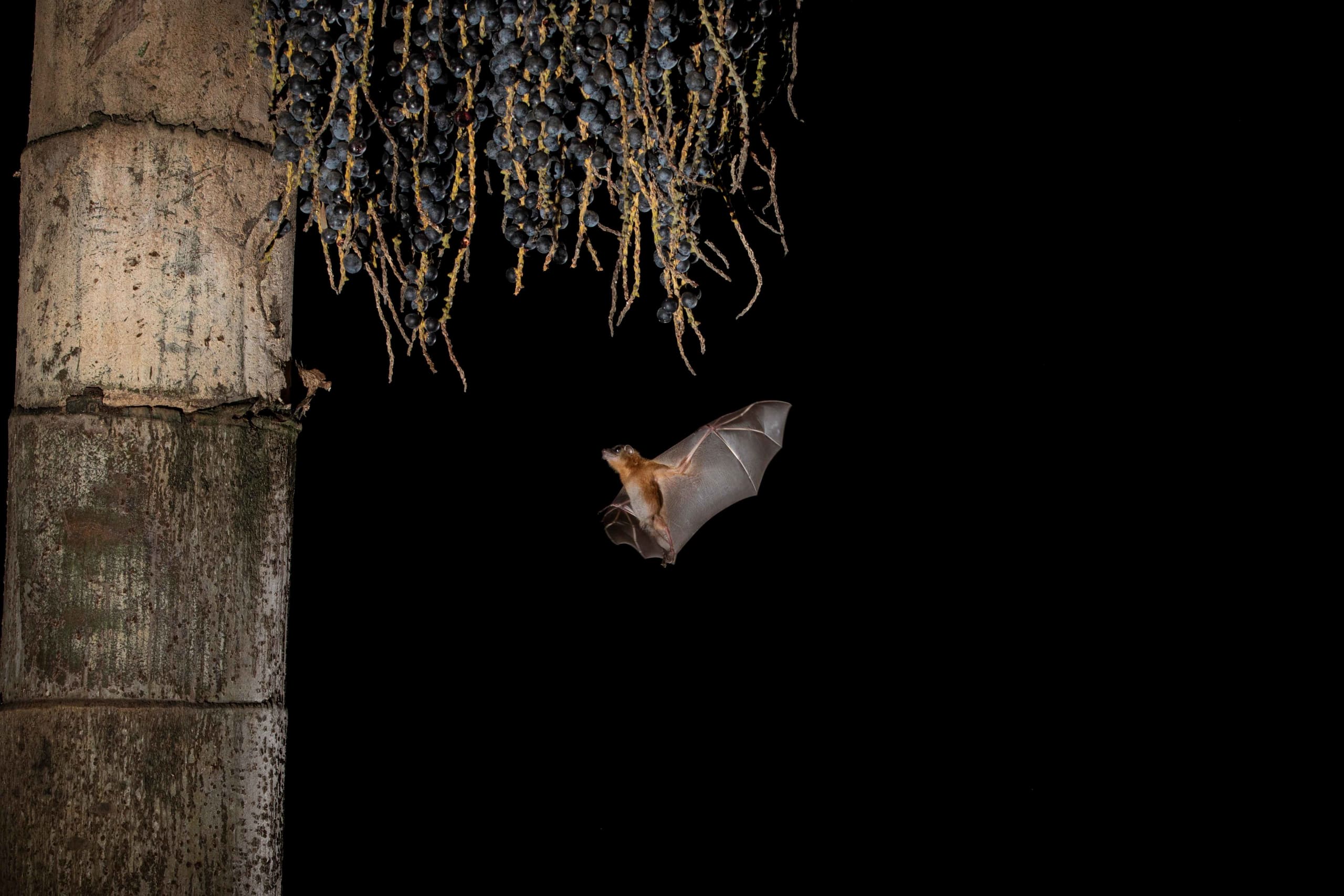 Listen to this article
•
15:34 min
Listen to this article
•
15:34 min
On the dirt road in front of my hostel at the Indian Institute of Science in Bengaluru lay a small black puff that I’d almost stepped on. Closer inspection revealed little clawed wings with paper-thin membranes that looked impossibly fragile. It was my first close encounter with a bat — nearly 15 years ago on a hot summer morning.
I managed to coax the bat into a small cardboard box and carried it to the Centre for Ecological Sciences, where I was sure I’d learn more about it. As predicted, several of the students there identified it as an Indian pipistrelle (Pipistrellus coromandra), an insectivore and one of the smallest bat species found in India with a 34-49 mm-long body and a wingspan of about 100–120 mm.
Ashok Kumar Mallik, a herpetology student with a flair for handling various exotic animals, deftly picked it up. When he brought a pipette with sugar-water near the tiny mouth, it opened to reveal rows of minuscule but impressively sharp teeth and began to lap up the sweet liquid. Ashok explained that small bats like pipistrelles often fall from their roosts due to dehydration during the hot summers, and they can be easily revived with some dilute sugar-water. That day, the bat rested in a cardboard box on my desk and was fed sugar-water several times. When it was cooler in the evening, Ashok and I released the diminutive pipistrelle where I’d found it. The bat swooped out of the box, looped around our heads twice and disappeared into nearby trees.
Since then, Ashok and I have completed our PhDs and gone our separate ways, but even today, I carry a small bottle of sugar-water and a plastic pipette in my purse during the summer. Although I’ve never gained the courage to handle bats, I have rehydrated (and hopefully saved) many little bats near my home in Bengaluru.
Bats in cities
Since that first encounter with a pipistrelle, I’ve observed other bat species in Bengaluru. At Sankey Tank, among the old tamarind and false Ashoka (Polyalthia longifolia) trees, I’ve seen large, raucous colonies of flying foxes (Pteropus giganteus). These are the largest bats in India, with 20-cm bodies and wingspans of up to 150 cm! They are frugivores (fruit-eaters) that can fly as much as a hundred kilometres every night in search of food. Another common fruit-eating bat is the short-nosed fruit bat (Cynopterus sphinx), often found flying around cluster fig (Ficus racemosa), Singapore cherry (Muntingia calabura), and jamun (Syzygium cumini) trees. These bats usually pick nightly roosts under window shades, overhangs, or tree branches and carry their food to these spots to feed. Such roosts have scatterings of chewed seed balls, leaf balls, and half-eaten fruits under them. Additionally, several other species of insectivores (like the pipistrelle) roost in old buildings, temples, and the undersides of tiled roofs.

Do cities need bats?
Yes. Cities need bats because they are keystone species in many environments and also important in urban environments. Keystone species are organisms (plants, animals, fish, birds, and others) that are crucial members of an environmental community. Bats are likely to be keystone species as they are prey for urban predators such as owls and raptors and perform ecosystem services such as pollination, seed dispersal, and pest control.
Several fruit-eating bat species pollinate mahua (Madhuca longifolia), kapok or silk cotton (Ceiba pentandra), banana and jamun trees planted as garden/avenue trees in cities. Other trees in urban areas, like the cluster fig, false Ashoka, guava, Singapore cherry, banyan, and peepal, benefit from the bats’ seed dispersal services. Insectivorous bats that roost in dark city buildings are voracious feeders, often consuming their body weight in insects in one single night, making them highly effective pest control agents. A 2021 study from Brazil shows that bats from urban areas forage in nearby cornfields and provide pest suppression services worth roughly USD 390 million per harvest.

Challenges in urban environments
However, in the Indian scenario, a study from Assam has shown that when urban areas are near paddy fields, bat activity in these paddy fields is affected, and bats are less effective as pest control agents than in other rural areas. The bright lights at night in cities can affect the natural flight rhythms of bats, such as when they leave their roosts to forage for food and when they return to their roosts to rest, which, in turn, may affect their physiology and health. Other studies show that urban night lighting (especially street and stadium lights), can also affect insect and bat activity — such lights seem to attract some species of bats (such as pipistrelles, which feed on the insects attracted by these lights), and deter others (for instance, light-shy cave-roosting species such as the Rousettus leschenaultii).
In addition to bright night-time light, loud noises, especially traffic in urban environments, can reduce bat activity and feeding. This is unsurprising since many bats use echolocation (where they produce high-pitched squeaks and detect the echoes of the squeaks) to orient themselves, detect prey, and communicate with each other.

Apart from light and sound pollution, urban areas are often deathtraps for bats, especially since overhead power lines and electric transformers electrocute bats that land on them. Added to this, tree-felling, rapid renovation of old buildings, and expanding urbanisation have left bats with fewer and fewer places to roost and forage, leading to local extinctions. Due to fears that bats may spread diseases in urban areas, many cities have also culled bats and destroyed their roosting areas.
Bat conservation efforts in cities
Unfortunately, bats are reservoirs for pathogens such as those causing Leptospira, rabies, Ebola, Nipah, and SARS, and COVID-19. While one study shows little support for cross-species transmission between bats and humans in cities, another indicates that urbanisation may be reducing bats’ immunity to disease and contributing to disease outbreaks in domestic animals and humans. Yet another study by ICMR has shown that Nipah virus outbreaks in humans correlate with bats infected with Nipah virus in the same area.

However, given the numerous important roles played by these aerial acrobats, most researchers and some city planners realise that bat conservation in cities must be taken seriously. Conserving avenue plantations and old buildings and constructing alternative roosting sites (such as bat boxes, bark mimics, and bat condos) are proposed measures to conserve bats in urban areas. Besides these, maintaining bat-accessible water sources and reducing noise and light pollution by creating low-light, low-noise, tree-covered “bat corridors” or preserving unmanaged land within cities may help create bat-friendly urban areas.
Wildlife rescue centres such as People for Animals (PFA) and Avian and Reptile Rescue Centre (ARRC) in Bengaluru, and the now (sadly) defunct Rehabber’s Den in Pune play a role in bat conservation as these places rescue and rehabilitate ill or injured bats.
Hopefully, we can modify our cities to convince bats to stay because while bats can undoubtedly manage without urban areas, our lives would be rather difficult without their services.









